Closed Stores: Difference between revisions
No edit summary |
|||
| (8 intermediate revisions by one other user not shown) | |||
| Line 3: | Line 3: | ||
|name = Infobox/doc | |name = Infobox/doc | ||
|bodystyle = | |bodystyle = | ||
|title = | |title = Closed Stores | ||
|titlestyle = | |titlestyle = | ||
|image = [[File:Closed_Stores.png|thumb|right|250px]] | |image = [[File:Closed_Stores.png|thumb|right|250px|Map of closed stores]] | ||
|imagestyle = | |imagestyle = | ||
|caption = Closed Stores in Venice compared to Percent Population Loss | |caption = Closed Stores in Venice compared to Percent Population Loss | ||
| Line 29: | Line 29: | ||
}} | }} | ||
Closed stores can be found throughout Venice even though the number of residents is significant and the number of tourists visiting the city each year have been steadily increasing. | |||
<br> | <br> | ||
==Types and Number of Stores== | ==Types and Number of Stores== | ||
There are a total of 1023 closed stores in Venice. These stores are | There are a total of 1023 closed stores in Venice. These stores are scattered throughout the city. | ||
[[File:1621000243_-12.JPG|thumb|center|400px|Closed Store (SP 243)]] | |||
<br> | <br> | ||
[[File:|center| | [[File:Closed_Stores.png|thumb|center|400px|Total Tourist Stores in Venice]] | ||
The islands with the highest density of closed stores are Cannaregio, Castello, San Marco, and San Polo, the districts with the higest percent population loss. | The islands with the highest density of closed stores are Cannaregio, Castello, San Marco, and San Polo, the districts with the higest percent population loss. | ||
[[File:High_conc._of_closed_stores.png| | [[File:High_conc._of_closed_stores.png|thumb|center|400px|Highest Densities of Closed Stores]] | ||
The islands with the lowest density of tourist stores are in Dorsoduro and Santa Croce, the districts with the lowest percent population loss. | The islands with the lowest density of tourist stores are in Dorsoduro and Santa Croce, the districts with the lowest percent population loss. | ||
[[File:Low_conc._of_closed_stores.png| | [[File:Low_conc._of_closed_stores.png|thumb|center|400px|Lowest Densities of Closed Stores]] | ||
The concentration of closed stores is not very high in the islands that have lost the most population, which is probably due to the population loss being offset by the growth of tourists in the area. Although the population is declining, the number of tourists keeps the demand for products high. | |||
[[File:Closed_stores_vs_population_loss.png|thumb|center|400px|Closed Stores vs Percent Population Loss]] | |||
[[File:Closed_stores_vs_growth_of_number_of_beds.png|thumb|center|400px|Closed Stores vs Hotel Bed Density]] | |||
<br> | <br> | ||
==NACE Coding System== | ==NACE Coding System== | ||
The NACE Coding System is a standard system used by the European Union in order to standardize how the data is categorized and to simplify the analysis of the trends in the stores and tourist accommodations in Venice. The code for closed stores is shown below. | The NACE Coding System is a standard system used by the European Union in order to standardize how the data is categorized and to simplify the analysis of the trends in the stores and tourist accommodations in Venice. The code for closed stores is shown below. | ||
''Closed'' Z00.00 <br> | ''Closed'' Z00.00 <br> | ||
| Line 64: | Line 69: | ||
* [http://www.wpi.edu/Pubs/E-project/Available/E-project-122610-202225/unrestricted/FinalReport_B10.pdf/ 2010 WPI Stores Project Team] | * [http://www.wpi.edu/Pubs/E-project/Available/E-project-122610-202225/unrestricted/FinalReport_B10.pdf/ 2010 WPI Stores Project Team] | ||
* [http://www.wpi.edu/Pubs/E-project/Available/E-project-122211-215914/unrestricted/ve11_Super_Final_Report_newest.pdf/ 2011 WPI Stores Project Team] | * [http://www.wpi.edu/Pubs/E-project/Available/E-project-122211-215914/unrestricted/ve11_Super_Final_Report_newest.pdf/ 2011 WPI Stores Project Team] | ||
==See Also== | ==See Also== | ||
Latest revision as of 19:24, 12 January 2014
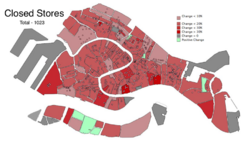 Closed Stores in Venice compared to Percent Population Loss | |
| Basic Information | |
|---|---|
| Types of Stores | |
Closed stores can be found throughout Venice even though the number of residents is significant and the number of tourists visiting the city each year have been steadily increasing.
Types and Number of Stores
There are a total of 1023 closed stores in Venice. These stores are scattered throughout the city.
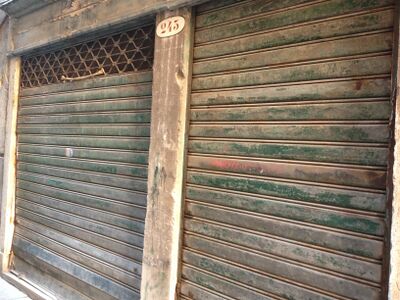
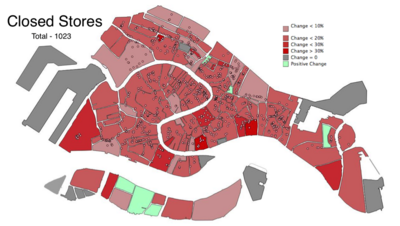
The islands with the highest density of closed stores are Cannaregio, Castello, San Marco, and San Polo, the districts with the higest percent population loss.
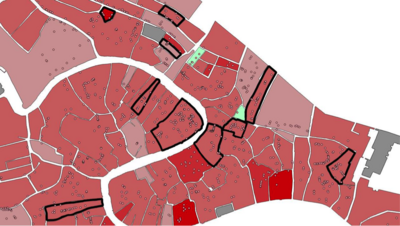
The islands with the lowest density of tourist stores are in Dorsoduro and Santa Croce, the districts with the lowest percent population loss.
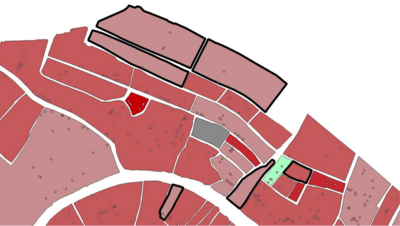
The concentration of closed stores is not very high in the islands that have lost the most population, which is probably due to the population loss being offset by the growth of tourists in the area. Although the population is declining, the number of tourists keeps the demand for products high.
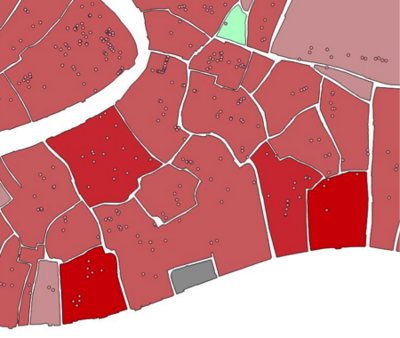
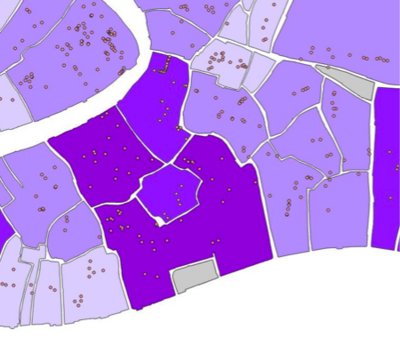
NACE Coding System
The NACE Coding System is a standard system used by the European Union in order to standardize how the data is categorized and to simplify the analysis of the trends in the stores and tourist accommodations in Venice. The code for closed stores is shown below.
Closed Z00.00
External Links
- 2004 WPI Stores Project Team
- 2005 WPI Stores Project Team
- 2007 WPI Stores Project Team
- 2009 WPI Stores Project Team
- 2010 WPI Stores Project Team
- 2011 WPI Stores Project Team
See Also
| |||||||||||||||||